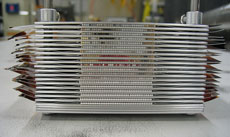Fermilab's technical centers contribute to T2K's success

The thin-films group within PPD's technical centers, led by Eileen Hahn, sputters thin layers of aluminum on the ends of optical fibers, as shown above, for applications in detectors such as the T2K near detector. Photo: Eileen Hahn
Advancements in high-energy physics rely on the combined efforts of hundreds of physicists and engineers from around the world.
Fermilab employees in the Particle Physics Division's technical centers are proud to have played a small role in the recent indications of neutrino oscillations by the T2K experiment in Japan, whose findings could lead to an explanation for why we live in a matter-dominated universe.
The thin films and scintillation detector development groups within the PPD's Technical Centers processed the optical fibers and developed scintillators that helped capture and amplify the light resulting from particle interactions in the T2K near detector.
Fermilab was chosen for this project because of its impressive track record and extensive experience with fiber processing and scintillation development, said Hogan Nguyen, who was the head of PPD's Technical Centers when this work was done.
"Even though Fermilab is not part of the T2K collaboration, the groups cared about it as though it was their own," Nguyen said. "It is really nice to finally see their work be part of an exciting new result from T2K, which will likely affect the future of Fermilab."
The thin-films group has 20 years of experience with fiber processing and has contributed to numerous particle physics experiments at Fermilab and beyond, including CDF, DZero, CMS and MINERvA. The group also oversaw the extruded scintillator fabrication for the MINOS and MINERvA experiments at Fermilab, and other projects at Jefferson Lab and Sandia National Laboratories.
The one-millimeter diameter fibers processed at Fermilab for T2K's near detector ranged from 1.6 to 4 meters long. About 40,000 fibers were processed by the five-member thin-films group, which is led by Eileen Hahn, who has been sputtering thin films on fibers at Fermilab for almost 20 years. Sputtering is a process driven by momentum between ions and atoms in different materials. Thin-films are sputtered by eroding a target and transferring the deposits to a different target.
To process the fibers, Hahn's team polished both ends and sputtered a thin layer of aluminum on one of the ends to act as a mirror to reflect light captured from particle interactions.
After a protective UV epoxy coating was placed on the mirrors, the fibers were precisely cut and subjected to quality control tests. The fibers were shipped to T2K collaborators at the University of Rochester in New York, the University of Regina in Canada, the Kyoto University in Japan and the University of Warwick in the United Kingdom, who incorporated them into various detector components.
The scintillators developed by the scintillator group for T2K consist of extruded polystyrene bars doped with two fluorescent additives and a white reflective coating. The group has been led by Fermilab chemist Anna Pla-Dalmau for 24 years.
The development of scintillators for neutrino detection involves the preparation of plastic bars with a particular shape and size as determined by the experiment and using a technique called extrusion. The final product is shipped to T2K collaborators in Japan, the United States and the United Kingdom for assembly in the detector.
Hahn and Pla-Dalmau are grateful that they could use their expertise to help numerous particle physics experiments, including T2K, make strides over the years.
"I am pleased to see that plastic scintillators continue to play a useful role in particle physics experiments," Pla-Dalmau said.
"It fills us with pride, even though we're aware that we're a very small part of it, to have played a small role in a scientific advancement," Hahn said.
—Christine Herman
|